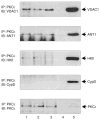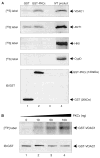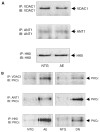Protein kinase Cepsilon interacts with and inhibits the permeability transition pore in cardiac mitochondria
- PMID: 12663490
- PMCID: PMC3691672
- DOI: 10.1161/01.RES.0000069215.36389.8D
Protein kinase Cepsilon interacts with and inhibits the permeability transition pore in cardiac mitochondria
Abstract
Although functional coupling between protein kinase Cepsilon (PKCepsilon) and mitochondria has been implicated in the genesis of cardioprotection, the signal transduction mechanisms that enable this link and the identities of the mitochondrial proteins modulated by PKCepsilon remain unknown. Based on recent evidence that the mitochondrial permeability transition pore may be involved in ischemia/reperfusion injury, we hypothesized that protein-protein interactions between PKCepsilon and mitochondrial pore components may serve as a signaling mechanism to modulate pore function and thus engender cardioprotection. Coimmunoprecipitation and GST-based affinity pull-down from mouse cardiac mitochondria revealed interaction of PKCepsilon with components of the pore, namely voltage-dependent anion channel (VDAC), adenine nucleotide translocase (ANT), and hexokinase II (HKII). VDAC1, ANT1, and HKII were present in the PKCepsilon complex at approximately 2%, approximately 0.2%, and approximately 1% of their total expression, respectively. Moreover, in vitro studies demonstrated that PKCepsilon can directly bind and phosphorylate VDAC1. Incubation of isolated cardiac mitochondria with recombinant PKCepsilon resulted in a significant inhibition of Ca2+-induced mitochondrial swelling, an index of pore opening. Furthermore, cardiac-specific expression of active PKCepsilon in mice, which is cardioprotective, greatly increased interaction of PKCepsilon with the pore components and inhibited Ca2+-induced pore opening. In contrast, cardiac expression of kinase-inactive PKCepsilon did not affect pore opening. Finally, administration of the pore opener atractyloside significantly attenuated the infarct-sparing effect of PKCepsilon transgenesis. Collectively, these data demonstrate that PKCepsilon forms physical interactions with components of the cardiac mitochondrial pore. This in turn inhibits the pathological function of the pore and contributes to PKCepsilon-induced cardioprotection.
Figures








References
-
- O’Rourke B. Myocardial KATP channels in preconditioning. Circ Res. 2000;87:845–855. - PubMed
-
- Baines CP, Liu GS, Birincioglu M, Critz SD, Cohen MV, Downey JM. Ischemic preconditioning depends on interaction between mitochondrial KATP channels and actin cytoskeleton. Am J Physiol. 1999;276:H1361–H1368. - PubMed
-
- Murata M, Akao M, O’Rourke B, Marban E. Mitochondrial ATP-sensitive potassium channels attenuate matrix Ca2+ overload during simulated ischemia and reperfusion: possible mechanism of cardioprotection. Circ Res. 2001;89:891–898. - PubMed
-
- Garlid KD, Paucek P, Yarov-Yarovoy V, Murray HN, Darbenzio RB, D’Alonzo AJ, Lodge NJ, Smith MA, Grover GJ. Cardioprotective effect of diazoxide and its interaction with mitochondrial ATP-sensitive K+ channels: possible mechanism of cardioprotection. Circ Res. 1997;81:1072–1082. - PubMed
-
- Fryer RM, Eells JT, Hsu AK, Henry MM, Gross GJ. Ischemic preconditioning in rats: role of mitochondrial KATP channel in preservation of mitochondrial function. Am J Physiol. 2000;278:H305–H312. - PubMed
Publication types
MeSH terms
Substances
Grants and funding
LinkOut - more resources
Full Text Sources
Research Materials
Miscellaneous

